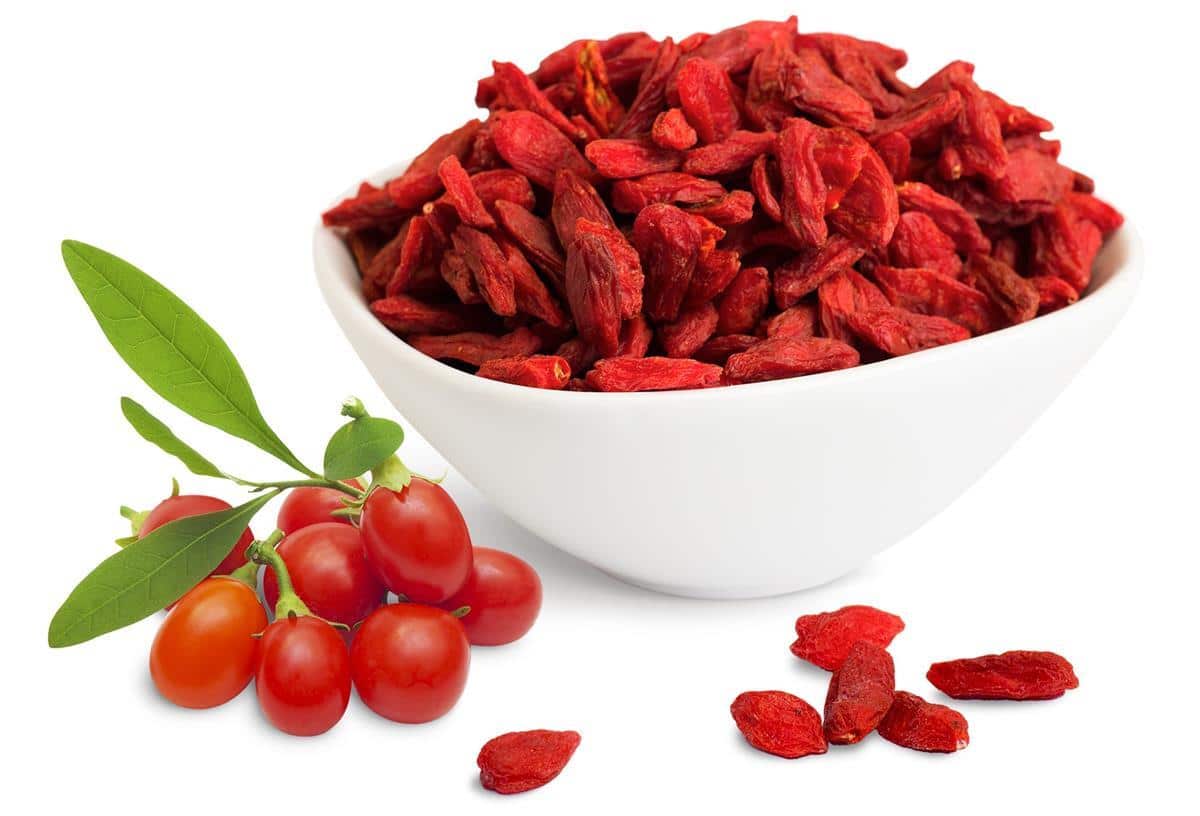13. Goji Berries:

They are usually found dried and shriveled and are similar to red resins in appearance. They are also known as wolf berries. They are usually cooked before consumption. They are used to prepare herbal tea, wines, rice congee, goji juice, etc. They contain 11 essential and 22 trace dietary minerals, 18 amino acids, 6 essential vitamins, carbohydrates, proteins, fats, dietary fiber, etc.
The goji berry is also called the wolfberry. It is a bright orange-red berry that comes from a shrub that’s native to China. In Asia, goji berries have been eaten for generations in the hopes of living longer.
Over time, people have used goji berries to treat many common health problems like diabetes, high blood pressure, fever, and age-related eye problems. Goji berries are eaten
raw, cooked, or dried (like raisins) and are used in herbal teas, juices, wines, and medicines.
Research shows that eating berries — like blueberries, acai berries, cranberries, strawberries, and cherries — offers some definite health benefits. Berries like the goji berry are filled with powerful antioxidants and other compounds that may help prevent cancer and other illnesses, including heart disease. Antioxidants may also boost the immune system and lower cholesterol.
Eating foods high in antioxidants may slow the aging process as well. It does this by minimizing damage from free radicals that injure cells and damage DNA. When a cell’s DNA changes, the cell grows abnormally. Antioxidants can take away the destructive power of free radicals. By doing so, antioxidants help reduce the risk of some serious diseases.
Goji berries also have compounds rich in vitamin A that may have anti-aging benefits. These special compounds help boost immune function, protect vision, and may help prevent heart disease.
Some research suggests that goji berry extracts may boost brain health and may protect against age-related diseases such as Alzheimer’s.
Other studies using goji berry juice founds benefits in mental well-being, and calmness, athletic performance, happiness, quality of sleep, and feelings of good health. These are preliminary studies that need to be repeated before definitive conclusions can be drawn.
While goji berries are a rich source of antioxidants — and early research shows a potentially powerful health benefit — it’s still unclear how they stack up against other berries.
Researchers also don’t know whether goji berry supplements have the same health benefits as the actual berries.
There may be some possible herb-drug interactions with goji berries. If you take warfarin (a blood thinner), you may want to avoid goji berries. Goji berries may also interact with diabetes and blood pressure drugs.
Also, if you have pollen allergies, you may want to stay away from this fruit.
Goji berries (Lycium barbarum) are the most nutritionally dense fruit on Earth. They are a member of the nightshade family (Solonaceae), which contains many other common vegetables such as potato, sweet potato, tomato, eggplant, and pepper, as well as some poisonous plants like belladonna and deadly nightshade. Native to the Himalayan Mountains of Tibet and Mongolia, the goji berry is now grown in many other countries as well.
Although they have only been introduced in Western countries in recent years, gojis have been used for thousands of years in Tibet and China, both as a culinary ingredient and medicinally.

Unique among fruits because they contain all essential amino acids, goji berries also have the highest concentration of protein of any fruit. They are also loaded with vitamin C, contain more carotenoids than any other food, have twenty-one trace minerals, and are high in fiber. Boasting 15 times the amount of iron found in spinach, as well as calcium, zinc, selenium and many other important trace minerals, there is no doubt that the humble goji berry is a nutritional powerhouse.
This amazing little superfruit also contains natural anti-inflammatory, anti-bacterial and anti-fungal compounds. Their powerful antioxidant properties and polysaccharides help to boost the immune system. It’s no wonder then, that in traditional Chinese medicine they are renowned for increasing strength and longevity.
In traditional Chinese medicine, the goji is said to act on the Kidney and Liver meridians to help with lower back pain, dizziness and eyesight. They are most often consumed raw, made into a tea or extract, or as an ingredient in soups.
Gojis are most commonly available in dried form, and make a great snack eaten as is, added to trail mix, muesli or oatmeal. They can also be soaked for a couple of hours in enough water to cover them. Then the soak water can be drained off and makes a delicious drink, or both water and berries added to smoothies.
Please note that there can be adverse interactions if you consume goji berries while also taking medication for diabetes, or blood pressure, or take the blood thinner warfarin. So be sure to consult your health care provider if that is the case.
Gojis can often be found in Asian food stores, but most of these come from the commercial growing regions of China and Tibet, and contain high levels of pesticides and synthetic fertilizers. Even some brands which claim to be organic may not be, so be sure to source your goji berries from a reputable source.
Disclaimer
The Content is not intended to be a substitute for professional medical advice, diagnosis, or treatment. Always seek the advice of your physician or other qualified health provider with any questions you may have regarding a medical condition.